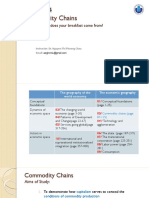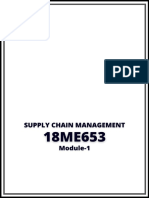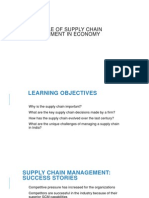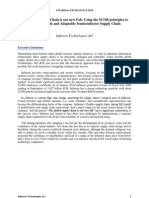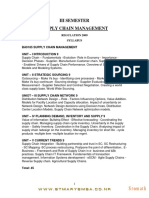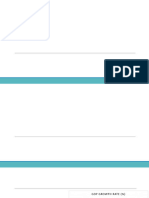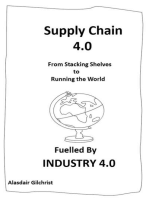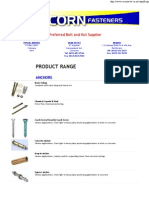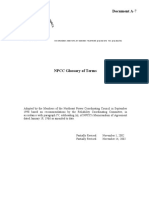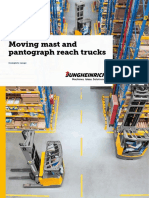Module Chapter 1
Uploaded by
D-Musics LuckyModule Chapter 1
Uploaded by
D-Musics LuckySupply Chain Management & Introduction to SAP (21ME641)
Module – 1
MODULE 1 CHAPTER 1
INTRODUCTION
Introduction: Supply Chain – Fundamentals –Evolution- Role in Economy - Importance - Decision
Phases – Supplier Manufacturer-Customer chain. - Enablers/ Drivers of Supply Chain Performance.
Supply chain strategy - Supply Chain Performance Measures.
INTRODUCTION
The supply chain encompasses all activities involved in the transformation of goods from the raw
material stage to the final stage, when the goods and services reach the end customer. Supply chain
management involves planning, design and control of flow of material, information and finance along
the supply chain to deliver superior value to the end customer in an effective and efficient manner. A
typical supply chain is represented in Figure 1.
Fig. 1 Typical Supply chain
• Supply chain management (SCM) is the design and management of flows of products,
information, and funds throughout the supply chain.
• A supply chain is the network of all entities involved in producing and delivering a finished
product to the final customer.
Department of Mechanical Engineering, ATME College of Engineering, Mysuru Page 1
Supply Chain Management & Introduction to SAP (21ME641)
Module – 1
• The supply chain includes sourcing raw materials and parts, manufacturing, producing, and
assembling the products, storing goods in warehouses, order entry and tracking, distribution, and
delivery to the final customer.
• The supply chain stages may include: suppliers, producers, wholesale/distributors, retailers, and
customers..
• The stages of the supply chain that comprise the inbound direction towards the company are
called upstream part of the supply chain. Example: Suppliers are upstream.
• The stages of the supply chain away from the firm are called downstream.
• Example: Distributors, retailers, and customers are downstream.
THE OBJECTIVE OF A SUPPLY CHAIN
The objective of every supply chain should be to maximize the overall value generated. The value (also
known as supply chain surplus) a supply chain generates is the difference between what the value of the
final product is to the customer and the costs the supply chain incurs in filling the customer’s request.
Supply Chain Surplus = Customer Value – Supply Chain Cost
The value of the final product may vary for each customer and can be estimated bythe maximum
amount the customer is willing to pay for it.
The difference between the value ofthe product and its price remains with the customer as
consumer surplus.
The rest of the supplychain surplus becomes supply chain profitability, the difference between
the revenue generatedfrom the customer and the overall cost across the supply chain.
Supply chain profitability is the difference between the revenue generated from thecustomer and
the overall cost across the supply chain.
Supply chain profitability is the total profit to be shared across all supply chain stages and
intermediaries.
The higher the supply chain profitability, the more successful is the supply chain.
Supply chain success is measured in terms of supply chain profitability and not in termsof the
profits at an individual stage
Revenue is from customer – positive cash flow
All other cash flows are simply fund exchanges that occur within the supply chain giventhat
different stages have different owners
All flows of information, product or funds generate costs within the supply chain.
Department of Mechanical Engineering, ATME College of Engineering, Mysuru Page 2
Supply Chain Management & Introduction to SAP (21ME641)
Module – 1
Supply chain management involves the management of flows between and among stagesin a
supply chain to maximize total supply chain profitability.
HISTORY OR EVOLUTIONOF SUPPLY CHAIN MANAGEMENT
The evolution of supply chain management has been a gradual process. Over the last century, there have
been three major revolutions in the field of supply chain management and we examine each of them in
the context of the broader evolution in the economic and technological environment.
1. THE FIRST REVOLUTION (1910–1920): VERTICAL INTEGRATED FIRMS
OFFERING LOW VARIETY OF PRODUCTS
There have been three major revolutions along this journey, and we examine each of them in the context
of the broader evolution in the economic environment.
The first major revolution was staged by the Ford Motor Company where they had managed to build a
tightly integrated chain. The Ford Motor Company owned every part of the chain right from the timber
to the rails. Through its tightly integrated chain, it could manage the journey from the iron ore mine to
the finished automobile in 81 hours. However, as the famous saying goes, the Ford supply chain would
offer any colour, as long as it was black; and any model, as long as it was Model T. Ford innovated and
managed to build a highly efficient, but inflexible supply chain that could not handle a wide product
variety and was not sustainable in the long run. General Motors, on the other hand, understood the
demands of the market place and offered a wider variety in terms of automobile models and colours.
Ford’s supply chain required a long time for set-up changes and, consequently, it had to work with a
very high inventory in the chain.
Till the second supply chain revolution, all the automobile firms in Detroit were integrated firms. Even
traditional firms in India, like Hindustan Motors, were highly integrated firms where the bulk of the
manufacturing was done in-house.
2. THE SECOND REVOLUTION (1960–1970): TIGHTLY INTEGRATED SUPPLY
CHAINS OFFERING WIDE VARIETY OF PRODUCTS
Towards the end of the first revolution, the manufacturing industry saw many changes, including a trend
towards a wide product variety. To deal with these changes, firms had to restructure their supply chains
to be flexible and efficient. The supply chains were required to deal with a wider product variety without
holding too much inventory. The Toyota Motor Company successfully addressed all these concerns,
thereby ushering in the second revolution.
Department of Mechanical Engineering, ATME College of Engineering, Mysuru Page 3
Supply Chain Management & Introduction to SAP (21ME641)
Module – 1
The Toyota Motor Company came up with ideas that allowed the final assembly and manufacturing of
key components to be done in-house. The bulk of the components was sourced from a large number of
suppliers who were part of the keiretsu system. Keiretsu refers to a set of companies with interlocking
business relationships and shareholdings.
The Toyota Motor Company had long-term relationships with all the suppliers. These suppliers were
located very close to the Toyota assembly plants. Consequently, set-up times, which traditionally used to
take a couple of hours, were reduced to a couple of minutes. This combination of low set -up times and
long-term relationships with suppliers was the key feature that propelled the second revolution—and it
was a long journey from the rigidly integrated Ford supply chain. The principles followed by Toyota are
more popularly known as lean production systems.
The Toyota system, involving tight linkages, did get into some problems in the later part of the century.
Gradually, when Toyota and other Japanese firms tried to set up assembly plants in different parts of the
world, they realized that they would have to take their suppliers also along with them. Further, they
found that some of the suppliers in keiretsu had become com-placent and were no longer cost
competitive. With the advent of electronic data interchange (EDI), which facilitated electronic exchange
of information between firms, it was possible for a firm to integrate with the suppliers without forcing
them to locate their plants close to the manufacturers’ plant.
In actual practice, the Toyota supply chain also had certain rigidities, such as a permanent relation with
suppliers, which could become a liability over a period of time. This, in turn, led to the third revolution
spearheaded by couple of progressive companies like Dell Computers, Apple Inc., and BhartiAirtel,
which offered, its customers the luxury of customization with loosely held supplier networks.
3. THE THIRD REVOLUTION (1995–2020): VIRTUALLY INTEGRATED GLOBAL
SUPPLY NETWORKS OFFERING CUSTOMIZED PRODUCTS AND SERVICES
Technology, especially information technology, which is evolving faster than enterprises can find
applications for some of the innovations, is the fuel for the third revolution in supply chain. It will
probably take at least couple of years before we can fully understand the IT-enabled model that has
emerged and begin to apply it to all industries. However, we have enough information to get a
reasonably good understanding of the contours of the third revolution. We will illustrate key
characteristics of the third revolution using the example of Dell computers, Apple Inc., and BhartiAirtel.
The first is a product company, the second combines product and service, and third is a pure service
organization. In each of these organisations, we will see different aspects of the third revolution.
Department of Mechanical Engineering, ATME College of Engineering, Mysuru Page 4
Supply Chain Management & Introduction to SAP (21ME641)
Module – 1
Dell computers allow customers to configure their own laptops (in terms of processors, video cards,
screen sizes, memory, etc.) and track the same in their production and distribution systems. Apple offers
personal digital devices to its customers and iPod is a classic example. However, it is not just about the
product. Apple allows the consumer to have a personalized user experience through the features and
services. Users can personalize the music and other media content on their device through the various
features available on iPod. Similarly, BhartiAirtel allows services like My Airtel through which
customer can have unique personalized experience.
As one can see we have moved to the stage where firms offer a bundle of goods that leads to
personalized experiences, which would be of great value to individual customer. Value is unique to each
customer, and therefore, each customer would wish a customized experience to be fully satisfied with
the value delivered to him or her. In summary, we have moved from single product (Model T black
colour) to wide variety as offered by Toyota to customization as offered by companies such as Dell
computers, Apple, and BhartiAirtel. Businesses can no longer be content in providing select product
variety to customers.
Organizations have moved from offering products to offering user experiences, which are a bundle of
goods and services selected by the user. This has changed the way supply chains are configured to
deliver value.
Let us begin with Dell. To make sure its customers get the completely customized product, Dell has
built a strong network of vendors who are cost and technology leaders. These medium term relationships
are based on the understanding that the vendors will adhere to a high benchmark on cost and technology
leadership which in turn will reflect in Dell’s products.
Apple Inc. brings together a product and a user experience in a revolutionary new way. Similar to Dell,
Apple has global partners with which it maintains medium term relationships based on cost and
technology benchmarking to fulfil its product manufacturing requirements. However, for creating a
better user experience, it has gone a step further by creating a platform that enables anyone to contribute
to the Apple user experience. Take the example of Apple iTunes and App Store. At the first level,
iTunes made it possible for Apple to provide all the music in the world to its users through a seamless
and tightly integrated platform. While this was only about entertainment, the App Store took it to the
next level
Department of Mechanical Engineering, ATME College of Engineering, Mysuru Page 5
Supply Chain Management & Introduction to SAP (21ME641)
Module – 1
ROLE IN ECONOMY
The growth of global supply chains has changed the distribution of incomes across countries.
Participation in these supply chains, initiated by the successful completion of low value-added
manufacturing tasks, contributed to industrialization and high rates of economic growth in
several Asian developing economies.
Manufacturing managers decide where to locate the company based on the costs of production.
That's led to a lot of jobs outsourcing in technology to India and China.
Many call - centers have outsourced to India and the Philippines. Natural disasters are becoming
an increasing threat that can disrupt any part of the supply chain.
The United Nations Refugee Agency reported their frequency has doubled in the last 20 years
due to global warming. The impact on local productivity can last decades after an event. If a
disaster is bad enough, it can slow global growth.
In 2011, Japan's earthquake and the resultant tsunami created the most damage to the world's
supply of automobiles, electronics, and semiconductor equipment.
The wings, landing gears, and other major airline parts are also made in Japan, so the quake
disrupted the production of Boeing's 787 Dreamliner. U.S. gross domestic product slowed in
2011 as 22 Japanese auto part plants suspended production.
Efficient management of the supply chain can reduce costs, maximize customer value, and
maximize competitive advantage. It entails effective coordination and control of linked sectors,
departments, systems, and organizations.
IMPORTANCE OF SUPPLY CHAIN
There is a close connection between the design and management of supply chain flows (product,
information, and funds) and the success of a supply chain. Walmart, Amazon, and Seven - Eleven Japan
are examples of companies that have built their success on superiordesign, planning, and operation of
their supply chain. In contrast, the failure of many online businesses, such as Webvan,can be attributed
to weaknesses in their supply chain design and planning. In the past, customers were not very
demanding and competition was not really intense. As a result, firms could afford to ignore issues
pertaining to the supply chain. Today, firms that do not manage their supply chain will incur huge
inventory costs and eventually end up losing a lot of customers because the right products are not
available at the right place and time.
Department of Mechanical Engineering, ATME College of Engineering, Mysuru Page 6
Supply Chain Management & Introduction to SAP (21ME641)
Module – 1
The following are the five major trends that have emerged to make supply chain management a critical
success factor in most industries and is shown in the below fig 2.
a. Proliferation in product lines: Companies have realized that more and more product variety is
needed to satisfy the growing range of customer tastes and requirements. This is evident from the
fact that every time a customer walks into a neighborhood store, he or she is bound to discover a
couple of items on the shelf that he or she had not seen during his or her last visit and that he or
she has more varieties to choose from now.
b. Shorter product life cycles: With increased competition, product life cycles across all industries
are becoming shorter. For example, technology leaders like Apple works with a life cycle as
short as 6 months.
c. Higher level of outsourcing: Firms increasingly focus on their core activities and outsource
non-core activities to other competent players. Michael Dell, the CEO of Dell Computers, had
mentioned that if his company was vertically integrated, it would need five times as many
employees and would suffer from a drag effect.
d. Shift in power structure in the chain: In every industry, the entities closer to customers are
becoming more powerful. With increasing competition, a steadily rising number of products are
chasing the same retail shelf space. Retail shelf space has not increased at the pace at which
product variety has increased. So there have been cases of retailers asking for slotting allowance
when manufacturers introduce new products in the market place.
Department of Mechanical Engineering, ATME College of Engineering, Mysuru Page 7
Supply Chain Management & Introduction to SAP (21ME641)
Module – 1
e. Globalization of manufacturing: Over the past decade, tariff levels have come down
significantly. Many companies are restructuring their production facilities to be at par with
global standards. Unlike in the past, when firms use to source components, produce goods and
sell them locally, now firms are integrating their supply chain for the entire world market.
The rise and subsequent fall of the bookstore chain “Borders” illustrates how a failure to adapt its supply
chain to a changing environment and customer expectations hurt its performance. Dell Computer is
another example of a company that had to revise its supply chain design in response to changing
technology and customer needs.
Department of Mechanical Engineering, ATME College of Engineering, Mysuru Page 8
Supply Chain Management & Introduction to SAP (21ME641)
Module – 1
Department of Mechanical Engineering, ATME College of Engineering, Mysuru Page 9
Supply Chain Management & Introduction to SAP (21ME641)
Module – 1
SUPPLY CHAIN PROCESSES
Department of Mechanical Engineering, ATME College of Engineering, Mysuru Page 10
Supply Chain Management & Introduction to SAP (21ME641)
Module – 1
• Supply chain processes fall into one of two categories depending on the timing of their
execution relative to customer demand
• Pull : Execution is initiated in response to a customer order (reactive).
• Push : Execution is initiated in anticipation of customer orders (speculative)
• Push/pull boundary separates push processes from pull processes
PUSH STRATEGY
Classical manufacturing supply chain strategy
Manufacturing forecasts are long-range
Orders from retailers’ warehouses
Longer response time to react to marketplace changes
Unable to meet changing demand patterns
Supply chain inventory becomes obsolete as demand for certain products disappears
Increased variability (Bullwhip effect) leading to:
Large inventory safety stocks
Larger and more variably sized production batches
Unacceptable service levels
Inventory obsolescence
Inefficient use of production facilities (factories)
How is demand determined? Peak? Average?
How is transportation capacity determined?
Examples: Auto industry, large appliances
Department of Mechanical Engineering, ATME College of Engineering, Mysuru Page 11
Supply Chain Management & Introduction to SAP (21ME641)
Module – 1
PULL STRATEGY
Production and distribution are demand-driven
Coordinated with true customer demand
None or little inventory held
Only in response to specific orders
Fast information flow mechanisms
POS data
Examples: Dell, Amazon
Decreased lead times
Decreased retailer inventory
Decreased variability in the supply chain and especially at manufacturers
Decreased manufacturer inventory
More efficient use of resources
More difficult to take advantage of scale opportunities
Department of Mechanical Engineering, ATME College of Engineering, Mysuru Page 12
Supply Chain Management & Introduction to SAP (21ME641)
Module – 1
SUPPLY CHAIN INTEGRATION – PUSH/PULL STRATEGIES
Hybrid of “push” and “pull” strategies to overcome disadvantages of each
Early stages of product assembly are done in a “push” manner
Partial assembly of product based on aggregate demand forecasts (which are more accurate than
individual product demand forecasts)
Uncertainty is reduced so safety stock inventory is lower
• Final product assembly is done based on customer demand for specific product
configurations
• Supply chain timeline determines “push-pull boundary”
Department of Mechanical Engineering, ATME College of Engineering, Mysuru Page 13
Supply Chain Management & Introduction to SAP (21ME641)
Module – 1
DECISION PHASES IN A SUPPLY CHAIN
Successful supply chain management requires many decisions relating to the flow of information,
product, and funds. Each decision should be made to raise the supply chain surplus. These decisions fall
into three categories or phases, depending on the frequency ofeach decision and the time frame during
which a decision phase has an impact. As a result, each category of decisions must consider uncertainty
over the decision horizon.
1. SUPPLY CHAIN STRATEGY OR DESIGN:
During this phase, a company decides how to structure the supply chain over the next several years. It
decides what the chain’s configuration will be, how resources will be allocated, and what processes each
stage will perform. Strategic decisions made by companies include whether to outsource or perform a
supply chain function in-house, the location and capacities of production and warehousing facilities, the
products to be manufactured or stored at various locations, the modes of transportation to be made
available along different shipping legs, and the type of information system to be used. Pepsi Co Inc.’s
decision in 2009 to purchase two of its largest bottlers is a supply chain design or strategic decision. A
firm must ensure that the supply chain configuration supports its strategic objectives and increases the
supply chain surplus during this phase. As the PepsiCo CEO announced in a news release on August 4,
“while the existing model has served the system very well, the fully integrated beverage business will
enable us to bring innovative products and packages to market faster, streamline our manufacturing and
distribution systems and react more quickly to changes in the marketplace.” Supply chain design
decisions are typically made for the long term (a matter of years) and are expensive to alter on short
notice. Consequently, when companies make these decisions, they must take into account uncertainty in
anticipated market conditions over the following few years. Strategic Changes are also underway in the
Indian Generic Drugs industry where the division between the Chronic Therapy and Acute Therapy
range of drugs is becoming sharper with more and more firms migrating from the later to the former.
This is a strategic shift to avail higher profit margins rather than operating in a highly competitive
environment in the Acute Therapy range where low-price leadership strategy seems to operate. Sun
Pharma, Doctor Reddy’s Laboratories Limited, Cipla, and Lupin have chosen to concentrate on the
chronic Therapy Range dealing in limited number of drugs with high profit margins. This shift supports
the belief that Low Price Leadership Strategy has its limitations and cannot be sustained over prolonged
periods.
Department of Mechanical Engineering, ATME College of Engineering, Mysuru Page 14
Supply Chain Management & Introduction to SAP (21ME641)
Module – 1
2. SUPPLY CHAIN PLANNING:
For decisions made during this phase, the time frame considered is from a quarter to a year. Therefore,
the supply chain’s configuration determined in the strategic phase is fixed. This configuration
establishes constraints within which planning must be done. The goal of planning is to maximize the
supply chain surplus that can be generated over the planning horizon given the constraints established
during the strategic or design phase. Companies start the planning phase with a forecast for the coming
year (or a comparable time frame) of demand and other factors, such as costs and prices in different
markets. Planning includes making decisions regarding which markets will be supplied from which
locations, the subcontracting of manufacturing, the inventory policies to be followed, and the timing and
size of marketing and price promotions. For example, steel giant Arcelor-Mittal’s decisions regarding
markets supplied by a production facility and target production quantities at each location are classified
as planning decisions. In the planning phase, companies must include uncertainty in demand, exchange
rates, and competition over this time horizon in their decisions. Given a shorter time frame and better
forecasts than in the design phase, companies in the planning phase try to incorporate any flexibility
built into the supply chain in the design phase and exploit it to optimize performance. As a result of the
planning phase, companies define a set of operating policies that govern short-term operations.
3. SUPPLY CHAIN OPERATION:
The time horizon here is weekly or daily. During this phase, companies make decisions regarding
individual customer orders. At the operational level, supply chain configuration is considered fixed and
planning policies are already defined. The goal of supply chain operations is to handle incoming
customer orders in the best possible manner. During this phase, firms allocate inventory or production to
individual orders, set a date by which an order is to be filled, generate pick lists at a warehouse, allocate
an order to a particular shipping mode and shipment, set delivery schedules of trucks, and place
replenishment orders. Because operational decisions are being made in the short term (minutes, hours, or
days), there is less uncertainty about demand information. Given the constraints established by the
configuration and planning policies, the goal during the operation phase is to exploit the reduction of
uncertainty and optimize performance. The design, planning, and operation of a supply chain have a
strong impact on overall profitability and success. It is fair to state that a large part of the success of
firms such as Walmart and Seven-Eleven Japan can be attributed to their effective supply chain design,
planning, and operation.
Department of Mechanical Engineering, ATME College of Engineering, Mysuru Page 15
Supply Chain Management & Introduction to SAP (21ME641)
Module – 1
SUPPLIER - MANUFACTURER - CUSTOMER CHAIN
In its simplest form, a supply chain is composed of a company and the suppliers and customers of that
company. This is the basic group of participants that creates a simple supply chain. Extended supply
chains contain three additional types of participants.
First there is the supplier’s supplier or the ultimate supplier at the beginning of an extended supply
chain. Then there is the customer’s customer or ultimate customer at the end of an extended supply
chain.
Finally, there is a whole category of companies who are service providers to other companies in the
supply chain. These are companies who supply services in logistics, finance, marketing, and information
technology. In any given supply chain, there is some combination of companies who perform different
functions. There are companies that are producers, companies that are distributors or wholesalers,
companies that are retailers,and companies or individuals that are the customers who are the final
consumers of a product. Supporting these four kinds of companies there are other companies that are
service providers providing a range of needed services. In this post we’ll look at the four main
participants in every supply chain.
a. Producers: Producers or manufacturers are organizations that make a product. This includes
companies that are producers of raw materials and companies that are producers of finished
goods. Producers of raw materials are organizations that mine for minerals, drill for oil and gas,
and cut timber. It also includes organizations that farm the land, raise animals, or catch seafood.
Producers of finished goods use the raw materials and sub-assemblies made by other producers
to create their products.
Department of Mechanical Engineering, ATME College of Engineering, Mysuru Page 16
Supply Chain Management & Introduction to SAP (21ME641)
Module – 1
b. Distributors: Distributors are companies that take inventory in bulk from producers and deliver
a bundle of related product lines to customers. Distributors are also known as wholesalers. They
typically sell to other businesses and they sell products in larger quantities that an individual
consumer would usually buy. Distributors buffer the producers from fluctuations in product
demand by stocking inventory and doing much of the sales work to find and service customers.
For the customer, distributors fulfill the “Time and Place” function – they deliver products when
and where the customer wants them.
A distributor is typically an organization that takes ownership of significant inventories
of products that they buy from producers and sell to consumers. In addition to product
promotion and sales, other functions the distributor performs are ones such as inventory
management, warehouse operations and product transportation as well as customer
support and post sales service.
A distributor can also be an organization that only brokers a product between the
producer and the customer and never takes ownership of that product. This kind of
distributor performs mainly the functions of product promotion and sales. In both these
cases, as the needs of customers evolve and the range of available products changes, the
distributor is the agent that continually tracks customer needs and matches them with
products available.
c. Retailers: Retailers stock inventory and sell in smaller quantities to the general public. This
organization also closely tracks the preferences and demands of the customers that it sells to. It
advertises to its customers and often uses some combination of price, product selection, service,
and convenience as the primary draw to attract customers for the products it sells. Discount
department stores attract customers using price and wide product selection. Upscale specialty
stores offer a unique line of products and high levels of service. Fast food restaurants use
convenience and low prices as their draw.
d. Customers: Customers or consumers are any organization that purchase and use a product. A
customer organization may be an organization that purchases a product in order to incorporate it
into another product that they in turn sell to other customers. Or a customer may be the final end
user of a product who buys the product in order to consume it.
Department of Mechanical Engineering, ATME College of Engineering, Mysuru Page 17
Supply Chain Management & Introduction to SAP (21ME641)
Module – 1
ENABLERS/ DRIVERS OF SUPPLY CHAIN PERFORMANCE
Enablers of Supply Chain Performance
The drivers of Supply chain performance are as follows:
1. Facilities: are the actual physical locations in the supply chain network where productis stored,
assembled, or fabricated. The two major types of facilities are production sites andstorage sites.
Decisions regarding the role, location, capacity, and flexibility of facilities have asignificant
impact on the supply chain’s performance. For example, in 2009, Amazon increasedthe number
of warehousing facilities located close to customers to improve its responsiveness. In contrast,
Blockbustertried to improve its efficiency in 2010 by shutting down many facilities even though
it reducedresponsiveness. Facility costs show up under property, plant and equipment, if
facilities areowned by the firm or under selling, general, and administrative if they are leased. 2.
2. Inventory encompasses all raw materials, work in process, and finished goods withina supply
chain. The inventory belonging to a firm is reported under assets. Changing inventorypolicies
can dramatically alter the supply chain’s efficiency and responsiveness. For exa mple,W.W.
Department of Mechanical Engineering, ATME College of Engineering, Mysuru Page 18
Supply Chain Management & Introduction to SAP (21ME641)
Module – 1
Grainger makes itself responsive by stocking large amounts of inventory and satisfyingcustomer
demand from stock even though the high inventory levels reduce efficiency. Such apractice
makes sense for Grainger because its products hold their value for a long time. A strategyusing
high inventory levels can be dangerous in the fashion apparel business where inventoryloses
value relatively quickly with changing seasons and trends. Rather than hold high levels
ofinventory, Spanish apparel retailer Zara has worked hard to shorten new product and
replenishmentlead times. As a result, the company is very responsive but carries low levels of
inventory.Zara thus provides responsiveness at low cost.
3. Transportation entails moving inventory from point to point in the supply chain.Transportation
can take the form of many combinations of modes and routes, each with its ownperformance
characteristics. Transportation choices have a large impact on supply chainresponsiveness and
efficiency. For example, a mail-order catalog company can use a faster modeof transportation
such as FedEx to ship products, thus making its supply chain more responsive,but also less
efficient given the high costs associated with using FedEx. McMaster-Carr andW.W. Grainger,
however, have structured their supply chain to provide next-day service to mostof their
customers using ground transportation. They are providing a high level of responsivenessat
lower cost. Outbound transportation costs of shipping to the customer are typically included
inselling, general, and administrative expense, while inbound transportation costs are
typicallyincluded in the cost of goods sold.
4. Information consists of data and analysis concerning facilities, inventory, transportation,costs,
prices, and customers throughout the supply chain. Information is potentially thebiggest driver of
performance in the supply chain because it directly affects each of the otherdrivers. Information
presents management with the opportunity to make supply chains moreresponsive and more
efficient. For example, Seven-Eleven Japan has used information to bettermatch supply and
demand while achieving production and distribution economies. The result isa high level of
responsiveness to customer demand while production and replenishment costs arelowered.
Information technology–related expenses are typically included under either operatingexpense
(typically under selling, general, and administrative expense) or assets. For example, in2009,
Amazon included $1.24 billion in technology expense under operating expense andanother $551
million under fixed assets to be depreciated.
Department of Mechanical Engineering, ATME College of Engineering, Mysuru Page 19
Supply Chain Management & Introduction to SAP (21ME641)
Module – 1
5. Sourcing is the choice of who will perform a particular supply chain activity such asproduction,
storage, transportation, or the management of information. At the strategic level,these decisions
determine what functions a firm performs and what functions the firmoutsources. Sourcing
decisions affect both the responsiveness and efficiency of a supply chain. After Motorola
outsourced much of its production to contract manufacturers in China, it saw itsefficiency
improve but its responsiveness suffer because of the long distances. To make up for thedrop in
responsiveness, Motorola started flying in some of its cell phones from China eventhough this
choice increased transportation cost. Flextronics, an electronics contract manufacturer,is hoping
to offer both responsive and efficient sourcing options to its customers. It is tryingto make its
production facilities in high-cost locations very responsive while keeping its facilitiesin low-cost
countries efficient. Flextronics hopes to become an effective source for all customersusing this
combination of facilities. Sourcing costs show up in the cost of goods sold, and monies owed to
suppliers are recorded under accounts payable.
6. Pricing determines how much a firm will charge for the goods and services that itmakes
available in the supply chain. Pricing affects the behavior of the buyer of the good or service,thus
affecting supply chain performance. For example, if a transportation company varies itscharges
based on the lead time provided by the customers, it is likely that customers who valueefficiency
will order early and customers who value responsiveness will be willing to wait andorder just
before they need a product transported. Differential pricing provides responsiveness tocustomers
that value it and low cost to customers that do not value responsiveness as much. Anychange in
pricing impacts revenues directly but could also affect costs based on the impact of thischange
on the other drivers.
Department of Mechanical Engineering, ATME College of Engineering, Mysuru Page 20
Supply Chain Management & Introduction to SAP (21ME641)
Module – 1
SUPPLY CHAIN STRATEGY
Supply chain strategy will have a major impact on creating value for a company and its supply chain
partners. An effective supply chain strategy may be formulated to meet the needs of the market and
integrate them with technology to generate the highest level of customer satisfaction while delivering the
highest value to the share-holders. Supply chain strategy is based on:
a. Collaboration strategy
b. Demand flow strategy
c. Customer service strategy
d. Technology integration strategy
a. Collaboration Strategy: Opportunities for collaboration among business partners will vary
depending upon the organization’s perspective role in the supply chain. The three main types of
collaboration are as follows:
i. Manufacturer - Supplier Collaboration: By collaborating with suppliers, manufacturers will
derive benefits in activities such as product development, order fulfillment and capacity
planning.
ii. Manufacturer - Customer Collaboration: The opportunities of collaboration between
manufacturers and customers are focused on demand planning and inventory replenishment.
This approach ensures that the customer requirements are met efficiently.
Department of Mechanical Engineering, ATME College of Engineering, Mysuru Page 21
Supply Chain Management & Introduction to SAP (21ME641)
Module – 1
iii. Collaboration with Third Party and Fourth Party Logistics Providers: The collaboration of
companies with 3rd party logistics providers focuses on jointly planning logistics activities.
It also gives the company the added advantage of better packaging. The 4th party logistics
organization is one of the intermediate stages along the logistics spectrum that combine the
benefits of outsourcing and insourcing.
b. Demand Flow Strategy: Traditionally, in supply chain management, the key focus and scope
has been in managing flow of goods from suppliers through the manufacturing and distribution
chain to the customer. The key in demand management is the continuous flow of demand
information from customer and end users through distribution and manufacturing to suppliers.
Customers can never be totally predictable but then a good demand flow strategy enables the
company to simplify their supply chain operations.
c. Customer Service Strategy: Customer satisfaction level is directly proportional to the service
provided by the company. Formulating a customer service strategy involves addressing 3 steps,
namely:
i. Customer Segmentation: A company has to decide on the segment it wants to target for a
particular commodity. It can decide not to have a homogenous market which is
unacceptable.
ii. Cost to Serve: It is important to obtain an impartial assessment of whether the things that the
customers want are feasible for the company. It is also important to determine the kind of
support needed from the suppliers or other parties in the supply chain. Finally, it is required
to project the cost of the support system and its feasibility of execution.
iii. Revenue Management: Determination of the appropriate response to the identified needs
and expectations of each customer segment must be completed. In short, the response which
maximizes the firm's profitability and growth should be determined.
d. Technology Integration Strategy: Developments in IT enabled the integration of business
information systems, both horizontally and vertically. A number of IT -based supply chain
information management tools are now available to provide intelligent decision support and
execution management. The main SCM approach today deals with the integration of all the
elements of a customer service focused organization, as shown in Figure.
Department of Mechanical Engineering, ATME College of Engineering, Mysuru Page 22
Supply Chain Management & Introduction to SAP (21ME641)
Module – 1
SUPPLY CHAIN PERFORMANCE MEASURES
Supply chain performance measure can be defined as an approach to judge the performance of supply
chain system. Supply chain performance measures can broadly be classified into two categories −
• Qualitative measures − For example, customer satisfaction and product quality.
• Quantitative measures − For example, order-to-delivery lead time, supply chain response time,
flexibility, resource utilization, delivery performance.
QUANTITATIVE MEASURES
Mostly the measures taken for measuring the performance may be somewhat similar to each other, but
the objective behind each segment is very different from the other.
FINANCIAL MEASURES
Cost of raw materials.
Revenue from goods sold.
Activity-based costs like the material handling, manufacturing, assembling rates etc.
Inventory holding costs.
Transportation costs.
Cost of expired perishable goods.
Penalties for incorrectly filled or late orders delivered to customers.
Credits for incorrectly filled or late deliveries from suppliers.
Cost of goods returned by customers.
Credits for goods returned to suppliers.
NON-FINANCIAL MEASURES
Cycle Time
Customer Service Level
Inventory Levels
Resource Utilization
Example of Supply Chain Performance Measurement using SCOR
An exhaustive list of supply chain performance measures is observed here along with its’ significant
impact of supply chain performance on business performance using benchmarking data and also the
methodology for linking the two.
Department of Mechanical Engineering, ATME College of Engineering, Mysuru Page 23
Supply Chain Management & Introduction to SAP (21ME641)
Module – 1
Among various sets of supply chain performance measures discussed in the literature, we focus on a set
of performance measures that have been most widely accepted in the industry. The Supply-Chain
Council is an independent, non-profit, global corporation interested in getting the industry to standardize
supply chain terms so that meaningful supply chain benchmarking can be carried out.
It has developed the Supply Chain Operations Reference (SCOR) model as the industry standard for
supply chain management. Several supply chain software vendors have adopted the SCOR performance
measures in their performance management module. SCOR recognizes six major processes: Plan,
Source, Make, Delivery, Return, and Enable.
As per the SCOR model, supply chain performance measures fall under the following five broad
categories:
i. Cost
ii. Assets (Asset Management Efficiency)
iii. Reliability
iv. Responsiveness
v. Agility
Further, the SCOR model develops 10 performance measures as shown in the figure. The Supply-Chain
Council refers to measures related to costs and assets as internal-facing measures, while reliability,
responsiveness, and agility are termed as customer-facing measures.
Typically, a firm offers a bundle consisting of price, delivery and flexibility to its customers. Price, in
competitive markets, is dictated by the market place. Thus, only delivery- and response-related measures
are termed as customer-facing measures. The performance measures related to assets and costs affect the
Department of Mechanical Engineering, ATME College of Engineering, Mysuru Page 24
Supply Chain Management & Introduction to SAP (21ME641)
Module – 1
profitability of the firm and are, thus, termed as internal-facing measures. The use of standard measures
allows firms to carry out meaningful benchmarking studies. Benchmarking studies carried out by the
Supply-Chain Council have shown that there are significant differences in performance across firms in
various industries.
SCOR measures, however, do not capture measures related to product variety. So, to that extent,
performance measures under the SCOR model do not seem to be comprehensive. While relating the
SCOR model to the cost versus customer service trade-off framework, we combine costs- and assets-
related measures.
Supply chain benchmarking using frameworks like SCOR is difficult to implement in countries in Asia
where data availability is a big problem. Alternatively, one may like to focus on fewer but important
metrics like costand assets utilization data, for which data are available in financial statements of listed
companies.
Department of Mechanical Engineering, ATME College of Engineering, Mysuru Page 25
You might also like
- Example Requirements Review Checklist: Intended Use of This ChecklistNo ratings yetExample Requirements Review Checklist: Intended Use of This Checklist2 pages
- Es-091 - W Passivation Treatment For Corrosion-Resistant Steel (Immunization)No ratings yetEs-091 - W Passivation Treatment For Corrosion-Resistant Steel (Immunization)12 pages
- Mobilization and Demobilization Equipment Rental Safety Requirements BarracksNo ratings yetMobilization and Demobilization Equipment Rental Safety Requirements Barracks4 pages
- 2010 Infineon Technologies AG SubmissionNo ratings yet2010 Infineon Technologies AG Submission13 pages
- Lecture 11 - Global Sourcing & SCM.pptxNo ratings yetLecture 11 - Global Sourcing & SCM.pptx55 pages
- History & Evolution of Supply Chain Managemant100% (7)History & Evolution of Supply Chain Managemant41 pages
- 01 M1 Supply Chain Management 27-01-2023 PDFNo ratings yet01 M1 Supply Chain Management 27-01-2023 PDF70 pages
- Mod 5 P&OM (21ME61) PART I&II Theory Questions R1No ratings yetMod 5 P&OM (21ME61) PART I&II Theory Questions R113 pages
- Module-1: Introduction To Supply Chain ManagementNo ratings yetModule-1: Introduction To Supply Chain Management10 pages
- Supply Chain Management - Unit 1 CompleteNo ratings yetSupply Chain Management - Unit 1 Complete52 pages
- 1.0 Introduction To Supply Chain Management (SCM)No ratings yet1.0 Introduction To Supply Chain Management (SCM)69 pages
- Intro & Global Supply Chain MGT Ver - Blemba12No ratings yetIntro & Global Supply Chain MGT Ver - Blemba1228 pages
- Supply Chain Management - Unit 1 Till 16febNo ratings yetSupply Chain Management - Unit 1 Till 16feb37 pages
- An Overview of The Impact of Additive Manufacturing On Supply Chain, Reshoring, and SustainabilityNo ratings yetAn Overview of The Impact of Additive Manufacturing On Supply Chain, Reshoring, and Sustainability10 pages
- 1a. Introduction To SCM: BIA 674 - Supply Chain AnalyticsNo ratings yet1a. Introduction To SCM: BIA 674 - Supply Chain Analytics32 pages
- Recent Development in The Field of SCM by Nimisha Nandan100% (2)Recent Development in The Field of SCM by Nimisha Nandan24 pages
- GIT-02_IT-Productivity-GameChanging-Platform (1)No ratings yetGIT-02_IT-Productivity-GameChanging-Platform (1)22 pages
- Supply Chain 4.0: From Stocking Shelves to Running the World Fuelled by Industry 4.0From EverandSupply Chain 4.0: From Stocking Shelves to Running the World Fuelled by Industry 4.03/5 (1)
- Military Supply Chain Management: From Deployment to Victory, Mastering the Logistics DanceFrom EverandMilitary Supply Chain Management: From Deployment to Victory, Mastering the Logistics DanceNo ratings yet
- Understanding the Industrial Internet the $$$ Trillion Opportunities for Your EnterprisesFrom EverandUnderstanding the Industrial Internet the $$$ Trillion Opportunities for Your EnterprisesNo ratings yet
- AutoCheck - Vehicle History Reports 1FMZU72K12ZC84591 VIN Check, Your Report57% (7)AutoCheck - Vehicle History Reports 1FMZU72K12ZC84591 VIN Check, Your Report4 pages
- ميحرلا نمحرلا الله مسب The Qualifying Program for Total Quality &Excellence Process ThinkingNo ratings yetميحرلا نمحرلا الله مسب The Qualifying Program for Total Quality &Excellence Process Thinking5 pages
- Moving Mast and Pantograph Reach Trucks OverviewNo ratings yetMoving Mast and Pantograph Reach Trucks Overview4 pages
- Checklist Form-034 - Rev.0-NFE Material Approval Request FormNo ratings yetChecklist Form-034 - Rev.0-NFE Material Approval Request Form1 page
- Mohammad Waqui Ur Rahman - Hse Officer (CV & Certificates)No ratings yetMohammad Waqui Ur Rahman - Hse Officer (CV & Certificates)13 pages
- Gravity Water Supply System Tools Manual PDF100% (2)Gravity Water Supply System Tools Manual PDF109 pages
- Linear Programming: The Graphical and Simplex MethodsNo ratings yetLinear Programming: The Graphical and Simplex Methods11 pages
- 2011 Ford Explorer 3.5L Ti-VCT Engine: Key FeaturesNo ratings yet2011 Ford Explorer 3.5L Ti-VCT Engine: Key Features2 pages
- Example Requirements Review Checklist: Intended Use of This ChecklistExample Requirements Review Checklist: Intended Use of This Checklist
- Es-091 - W Passivation Treatment For Corrosion-Resistant Steel (Immunization)Es-091 - W Passivation Treatment For Corrosion-Resistant Steel (Immunization)
- Mobilization and Demobilization Equipment Rental Safety Requirements BarracksMobilization and Demobilization Equipment Rental Safety Requirements Barracks
- An Overview of The Impact of Additive Manufacturing On Supply Chain, Reshoring, and SustainabilityAn Overview of The Impact of Additive Manufacturing On Supply Chain, Reshoring, and Sustainability
- 1a. Introduction To SCM: BIA 674 - Supply Chain Analytics1a. Introduction To SCM: BIA 674 - Supply Chain Analytics
- Recent Development in The Field of SCM by Nimisha NandanRecent Development in The Field of SCM by Nimisha Nandan
- Supply Chain 4.0: From Stocking Shelves to Running the World Fuelled by Industry 4.0From EverandSupply Chain 4.0: From Stocking Shelves to Running the World Fuelled by Industry 4.0
- Military Supply Chain Management: From Deployment to Victory, Mastering the Logistics DanceFrom EverandMilitary Supply Chain Management: From Deployment to Victory, Mastering the Logistics Dance
- Understanding the Industrial Internet the $$$ Trillion Opportunities for Your EnterprisesFrom EverandUnderstanding the Industrial Internet the $$$ Trillion Opportunities for Your Enterprises
- AutoCheck - Vehicle History Reports 1FMZU72K12ZC84591 VIN Check, Your ReportAutoCheck - Vehicle History Reports 1FMZU72K12ZC84591 VIN Check, Your Report
- ميحرلا نمحرلا الله مسب The Qualifying Program for Total Quality &Excellence Process Thinkingميحرلا نمحرلا الله مسب The Qualifying Program for Total Quality &Excellence Process Thinking
- Checklist Form-034 - Rev.0-NFE Material Approval Request FormChecklist Form-034 - Rev.0-NFE Material Approval Request Form
- Mohammad Waqui Ur Rahman - Hse Officer (CV & Certificates)Mohammad Waqui Ur Rahman - Hse Officer (CV & Certificates)
- Linear Programming: The Graphical and Simplex MethodsLinear Programming: The Graphical and Simplex Methods
- 2011 Ford Explorer 3.5L Ti-VCT Engine: Key Features2011 Ford Explorer 3.5L Ti-VCT Engine: Key Features



